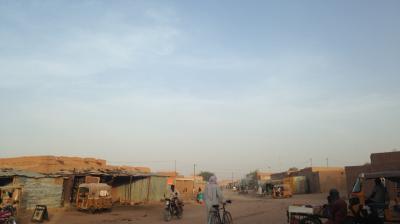Migration and Development in the new EU Budget
Since 2015, the EU Emergency Trust fund for Africa (EUTF) has been disbursing funds to “tackle root causes to irregular migration and forced displacement” in North, East and West Africa. New programming through the fund ends in 2020. As evident from current proposals for the external component of the next Multiannual Financial Framework (MFF), the approach which underpinned the EUTF is likely to expand and become an institutionalized part of EU development policy. To take stock of what this means for migration and development in the Sahel, this commentary will analyse lessons learnt from EUTF implementation in Mali and Niger.
Since the early 2000s there has been a clear trend of increased securitization and externalization of EU borders in order to reduce irregular migration. The so-called migration crisis of 2015 marked a turning point as parts of the securitization and externalization approach started to encroach into the development policy domain with the creation of the Emergency Trust Fund for Africa (EUTF).
While the fund was external to the EU budget and consisted of voluntary donations from member states’ aid budget and the European Development Fund, it became part of the EU´s comprehensive approach to migration and security. This included increased collaboration with transit and origin countries in order to reduce migration. Development spending was a key tool in establishing and upholding this approach both by conditionalizing access to development funds on cooperation on migration issues, and by channelling funds to projects which were framed to disincentivize individuals from migrating north.
As observed by many in the past five years, this approach was aggressively pursued in the Sahel, which has been described as the laboratory or experiment of the EU´s comprehensive approach to security and migration. Judging from the current MFF proposal, which suggests that 10 % of the soon-to-be-established € 79.46 billion Neighbourhood, Development and International Cooperation Instrument (NDICI) should be earmarked for migration and development, it appears that the experiment has been deemed successful. As a consequence, the EUTF approach seems to be absorbed into the new instrument and will transition into an institutionalized part of the EU budget, something that is also echoed in the external dimension of the recently announced EU Pact on Migration and Asylum, the external dimension of which seems to continue to focus on the so called root causes approach. Pending budget negotiations, migration and development is also likely to receive significantly increased funding, through the NDICI fund as well as various internal funding mechanisms that are open to programming in third countries. Yet despite considerable political buy-in, numerous questions on the underlying logic and the consequences of the experiment remain.
The EUTF - Policy Competition or Coherence?
Policy coherence is one of the fundamental principles that EU development policy is evaluated on and which is enshrined in its Treaties. Yet the thinking around the migration-development nexus on which much of the EUTF is based on, displays a rich example of policy incoherence. The past years have seen the rising prominence of nexuses, i.e. the pairing of different policy areas in order to create synergies and policy reinforcement, as evident in the trade-development and climate-development nexuses. In reality however, nexuses often present explicit or implicit policy conflict and competition. The migration development nexus, as it has been pursued by the EU, is in practice built on two separate policy objectives. On the one hand the objective of reducing European bound migration and on the other hand the Lisbon treaty-based objective of reducing and eventually eradicating poverty. EUTF implementation showcases that the objectives in practice tend to not only compete, but potentially also undermine each other. Migration deterrence may have negative effects on poverty reduction and human security, while development in turn could result in more migration.
"Migration deterrence may have negative effects on poverty reduction and human security, while development in turn could result in more migration."
A case in point of the negative effects of migration deterrence is Niger, and the northern city of Agadez in particular. Since the migration crisis of 2015, Niger has received the highest amount of EU development assistance per capita in the world. In connection to this, the EU was instrumental in pushing to ensure that Niger implemented strict laws against smuggling and effectively shut down north bound migration. Although the approach was admittedly successful at reducing north bound migration in the short term, studies show that it was less successful at reducing poverty and may have had a wide range of perverse effects. With the town of Agadez being an important transit hub for north bound migration, migrants were a key source of revenue. The partial shut-down of the smuggling industry resulted in increased poverty and also displayed considerable disregard to rule of law and good governance. EUTF implementation in Niger thereby illustrates the competition between poverty reduction and migration deterrence and showed that when push comes to shove, migration deterrence holds a stronger position. A recently published report by the Clingendael Institute looks at how, four years after the start of the implementation of migration control measures, lasting effects are becoming visible both on the region’s economy as well as on local governance providers.
Policy incoherence is also visible in relation to the gendered effects of pairing development spending with migration (deterrence). Although women make up nearly half of all migrants globally, some regions show significantly more men on the move than women, especially in Europe bound migration. Mali is one of these countries, where the majority of migrants heading to Europe are young men. Thereby, according to the logic which underpins the EUTF of providing job opportunities to disincentivize migration, beneficiaries are likely targeted based on their potential to migrate. This in turn results in young men being attractive targets, despite being relatively resource rich compared to women. The male bias tendency is apparent in data on beneficiaries of EUTF projects in Mali, as when gender disaggregated data is provided, men make up a majority of final beneficiaries. This dynamic risks exaggerating gendered inequalities and challenges both the EU´s commitment to targeting beneficiaries according to vulnerability, and its ambitious gender mainstreaming agenda.
Moreover, and fundamentally, migration research indicates that policy incoherence could be apparent in the very narrative which the EUTF was based on, namely that migration is driven by underdevelopment. Research findings contradict this narrative and show that development tends to result in increased migration, since once people have surplus resources they are also more able to finance a migration journey. By this logic EU efforts to contribute to development in countries of origin to reduce migration could potentially be fruitless. It is important to highlight that migration research is still indecisive of the exact effects of development on migration, with some findings concluding that institutional development can potentially, in the long term, reduce migration.
"Migration research is still indecisive of the exact effects of development on migration."
Taking stock of EUTF programming in Mali and Niger, it appears that the paradox of increased development leading to increased migration, has to some degree been circumvented by funding projects which arguably fall outside normative development. This includes using development funds to finance border management, migration prevention and the dismantling of smuggling networks, effectively coercing third countries to function as EU border guards. The approach has been coined the migration-security-development nexus, and considering its efficiency at reducing migration, it is likely to dominate future EU development programming. In relation to this, it is important to continue to question whether the TFEU enshrined primary objective of all EU development programmes to contribute to the “reduction and long-term eradication of poverty”, regardless of its effect on migration, resonates with the financing of border patrols.
Outlook
One potential positive effect of the institutionalization of the EUTF within the MFF is that it will lead to increased transparency and give the European Parliament stronger competencies to scrutinize. The EUTF has previously been criticized for lacking transparency by both NGOs and the European Court of Auditors, who attribute this to be a result of its rapid flexible programming design. However, although transparency will de facto increase as the EUTF approach is absorbed into the MFF, there is a risk that the issues related to monitoring rapid and flexible development programming may spread to other areas of the EU development budget and result in less overall transparency of development funding.
The proposal of dedicating 10 % of the NDICI budget to migration and development was made in the original Commission proposal in 2018. In subsequent meetings the parliament has been critical of migration objectives being pursued at the expense of development and are pushing for unconditionality. The Commission, and many EU Member States, meanwhile insist that development funds can be made conditional on cooperation on migration. While such a solution may be effective at hindering migration, it is yet to be seen whether this is reconcilable with desirable longer term outcomes enshrined in the Treaties.
"EUTF implementation in the Sahel showcases a number of incoherencies and potentially dangerous consequences in regard to poverty reduction and gender inequality."
As has been illustrated, EUTF implementation in the Sahel showcases a number of incoherencies and potentially dangerous consequences in regard to poverty reduction and gender inequality. The institutionalization of the EUTF approach, and the principles which underpin it, into the MFF should thereby be viewed with scepticism. Under the ongoing negotiations around programming for the next budgetary cycle, it is advisable that the 10 % spending target for migration and development under NDICI is kept as a maximum limit, and that non allocated parts of funding instruments do not end up financing migration programming. As for the next 7 years of development programming under the new MFF, it is important to utilize the increased transparency to monitor and question the implementation of incoherent, gender biased and potentially poverty increasing programming that is primarily aimed at reducing European bound migration.
Follow @JohannesClaes and @Clingendaelorg on Twitter and subscribe to our newsletter 'Echoes of the Sahel'.






